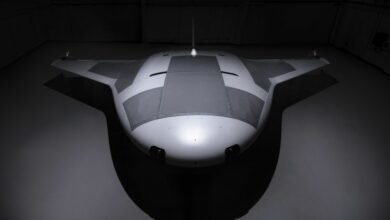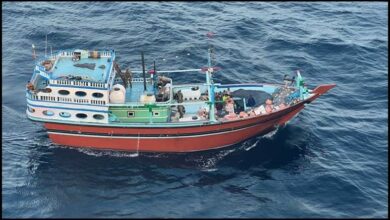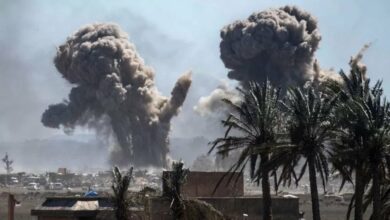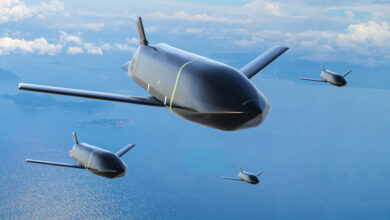‘Incredibly Complex’: The US Raid That Killed IS Chief Qurashi
By early December US intelligence was certain: the man occupying the top floor of a nondescript house in Atme, northern Syria — who never left the premises, emerging only to bathe on the roof — was the head of the Islamic State group.
In the White House Situation Room, a table-top model of the house was set up, and President Joe Biden was briefed on his options to neutralize Abu Ibrahim al-Hashimi al-Qurashi, one of America’s most wanted jihadist targets.
US officials say they could have easily killed Qurashi — whose location they had narrowed down last year before pinpointing it — with a precision missile.
Biden chose a riskier course, said a senior US official briefing reporters Thursday, to reduce the possibility of killing the civilians also living in the three-level cinderblock home, set amid olive trees near the Turkish border.
The Special Operations Forces assault launched early Thursday was “incredibly complex,” the official said, given several nearby homes and the presence of women and multiple children in the building.
In the end, as elite US troops surrounded the house calling for all inside to come out, Qurashi blew himself up along with his wife and two children — an outcome the Americans had prepared for but hoped against.
TRT gets exclusive access to the building where a US operation killed Daesh leader Abu Ibrahim al Hashimi al Qurayshi pic.twitter.com/EgkZvoekBg
— TRT World Now (@TRTWorldNow) February 3, 2022
The “massive” explosion ejected multiple people from the building including Qurashi, who was found dead on the ground outside the building, according to General Kenneth McKenzie, head of US Central Command.
“Fingerprint and DNA analysis had confirmed that he was Haji Abdullah,” McKenzie said, using the Pentagon’s name for Qurashi.
The operation had been repeatedly rehearsed in detail. Special forces trained for everything from surrender to a firefight, and one possibility was that Qurashi would blow himself up.
“One of our main concerns was that he would kill himself and the structure would collapse killing everyone else in the building,” said a senior military official.
The operation team consulted engineers on the strength of the concrete building, the official said. They concluded with “high confidence” that an explosion would only destroy the top floor.
The hideout’s location in Idlib province was just 15 kilometers (nine miles) north of where Qurashi’s IS predecessor, Abu Bakr al-Baghdadi, likewise killed himself in 2019 to avoid US capture.
The United States had placed a $10 million reward on Qurashi’s head when he took the IS helm.
Early this week Biden was briefed on the situation, and gave the operational go-ahead Tuesday.
Last night’s operation is a testament to America’s reach and capability to take out terrorist threats — no matter where they try to hide in the world.
I am determined to protect the American people from terrorist threats, and I will take decisive action to protect this country.
— President Biden (@POTUS) February 3, 2022
Questions on Civilian Deaths
The raid went according to plan — almost.
As Biden, Vice President Kamala Harris, and other officials monitored in real time in the Situation Room, helicopters flew in US commandos who surrounded the building and warned off neighbors.
The team called on everyone to exit the building, and a couple and their children living on the first level emerged and were taken to safety, the senior official explained.
Moments later, the top floor erupted with an explosion, tearing off half the structure but leaving the level below intact.
US forces began moving in, but a couple on the second floor barricaded themselves in their residence and began firing on them.
“The ISIS lieutenant and his wife were killed,” the official said, without offering details, adding that four children emerged to be taken to safety.
After the raid open questions remained about how many people died.
The Syrian Observatory for Human Rights said seven civilians were among at least 13 people killed, four of them children.
Pentagon spokesman John Kirby said at least three civilians died — Qurashi’s wife and their two children.
The US military official meanwhile said eight children and two adults were saved. But the official allowed it was not clear how many children were on the top floor when it exploded, and that a couple below may have had more children with them.
US forces took incoming fire from unknown local gunmen during the raid, the official said. The US troops fired back, killing at least two, with no Americans injured.
In operational terms, officials said, the only mishap was that one of the helicopters delivering commandos to the location developed mechanical problems and landed in a nearby field, where it was destroyed.
That echoed the 2011 raid on the Pakistan compound of Al-Qaeda leader Osama bin Laden, where a US helicopter crash-landed and had to be destroyed, due to sensitive technology onboard.











